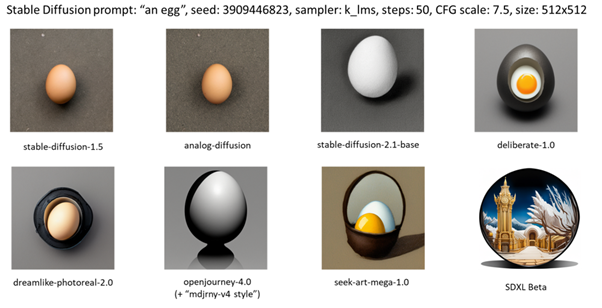
Generative AI is a tool for productivity
If we want to get the productivity gains from AI then we are going to have to teach each other how to use it. At the Blockchain Innovation Hub, our basic thesis is that this technology is bottom up adopted technology. It is not being introduced from the top of an organisation. It is being adopted by us as practitioners, who have specific tasks and we need the technology to make us more productive.
What is GenAI?
A simple explanation is that GenAI takes an input – a question or phrase - and it makes a prediction about what the next output is likely to be, in response to the question.
For researchers, we’re probably mostly going to be thinking about text-to-text GenAI such as ChatGPT, Google Bard and Claude etc. But there are also Text to image services (DALLE-E, Midjourney, Stable Diffusion), text to audio (Google AudioLM, Whisper), and even services that can act on our behalf (AutoGPT)
As researchers, we need to pay attention to GenAI technology right now. Microsoft have promised to integrate GPT4 into every single one of its Office Suite by the end of 2023 and Google is not far behind them. Once this happens it is going to be like a bomb going off in every workplace on the planet that uses Microsoft Word or Google Docs. Everyone is going to have this technology. Our only choice is to adapt to it immediately.
AI for research
There are three ways we can use AI as research scholars:
1. We can use Gen AI as our mentor. One interesting way to use GenAI is to ask it as an educator. It is like a mentor that harnesses only the knowledge that you provide it. The outcome is education tailored specifically for you.
It also eliminates what we have all felt when asking questions to real world mentors - that sense of shame when we don’t fully understand something that we believe should be obvious. It’s hard to be embarrassed in front of a robot.
2. It can be used as an analytic tool. AI used in research is old news - we have been using it for at least a decade in large scale research projects. What is exciting about this new generation of AI tools is that we can use it to build new tools that work for us, and build them quickly.
Using GenAI for tool-building allows us to test ideas and throw them away if we don’t like them. For example, we might want to build an economic simulations in Python, but have previously lacked the time or skill to do so. Fast iteration with GenAI allows us to test ideas and see if our research is moving productively. It saves time in what would normally take weeks or even months if done manually.
3. It can be used as a writing tool. GenAI that it helps reduce the mundane work of so much writing. For me, the most powerful use of GenAI is to prevent writer’s block. So often when I am writing, I have an idea in my head, but I don’t know how to express it. With ChatGPT, I type out the crudest possible version of the idea, and ask it to regurgitate the same idea back “but more eloquently”. This works almost every time – allowing me to continue moving through my writing at pace. If it doesn’t give you what you want, you prod it and prompt it again.
The Model really matters
It is important to understand the output of generative AI, it is important to understand how it is built. Generative AI models are built on a foundation model – a general model trained on huge amounts of raw data, text, images and so forth. The model is then trained through additional, specialised enforcement learning – often using human feedback, which is a specific dataset. This refines the model, allowing it to understand when something is a question (for example), and teaches it to avoid outputting offensive or harmful responses.
It is for this latter reason that you the more you use GenAI, the more you will learn about the peculiarities of the model you’re using. To be productive with ChatGPT, for example, you’ll want to have a good idea of the strengths and weaknesses of GPT 3.5 and 4.0.
To illustrate this, I’ve asked an open-source generative AI image creater, Stable Diffusion to draw me “an egg”, but with 8 different models. You’ll be able to see the wide variety of responses it gave.

The reason the last image doesn’t look like an egg is because it has been overtrained through reinforced learning by human feedback. Understanding that different models you use have varied outputs is one of the skills that you are going to have to pick up if you are going to use AI successfully.
Productivity tool
There is widespread concern when using AI that you are going to get the wrong information, facts or ‘hallucinations’. I think this is closely connected to a belief that AI could – or should - replace researchers in the medium to long term. Of course, we need to check and verify the results that AI produces. If we are to put our name on research we are responsible for it.
But more importantly, hallucinations should be a problem for us as academic researchers. GenAI is not a means for replacing academics. It works best when we know what a correct output should be. It is a tool that can make us significantly more productive.
Author:
Associate Professor Chris Berg
Director, Blockchain Innovation Hub
Advancing Academic Research through Gen AI Workshop 24 May 2023.
For more information and to hear from other researchers about Gen AI for Academic Research, watch the full presentation here


Acknowledgement of Country
RMIT University acknowledges the people of the Woi wurrung and Boon wurrung language groups of the eastern Kulin Nation on whose unceded lands we conduct the business of the University. RMIT University respectfully acknowledges their Ancestors and Elders, past and present. RMIT also acknowledges the Traditional Custodians and their Ancestors of the lands and waters across Australia where we conduct our business - Artwork 'Sentient' by Hollie Johnson, Gunaikurnai and Monero Ngarigo.
More information